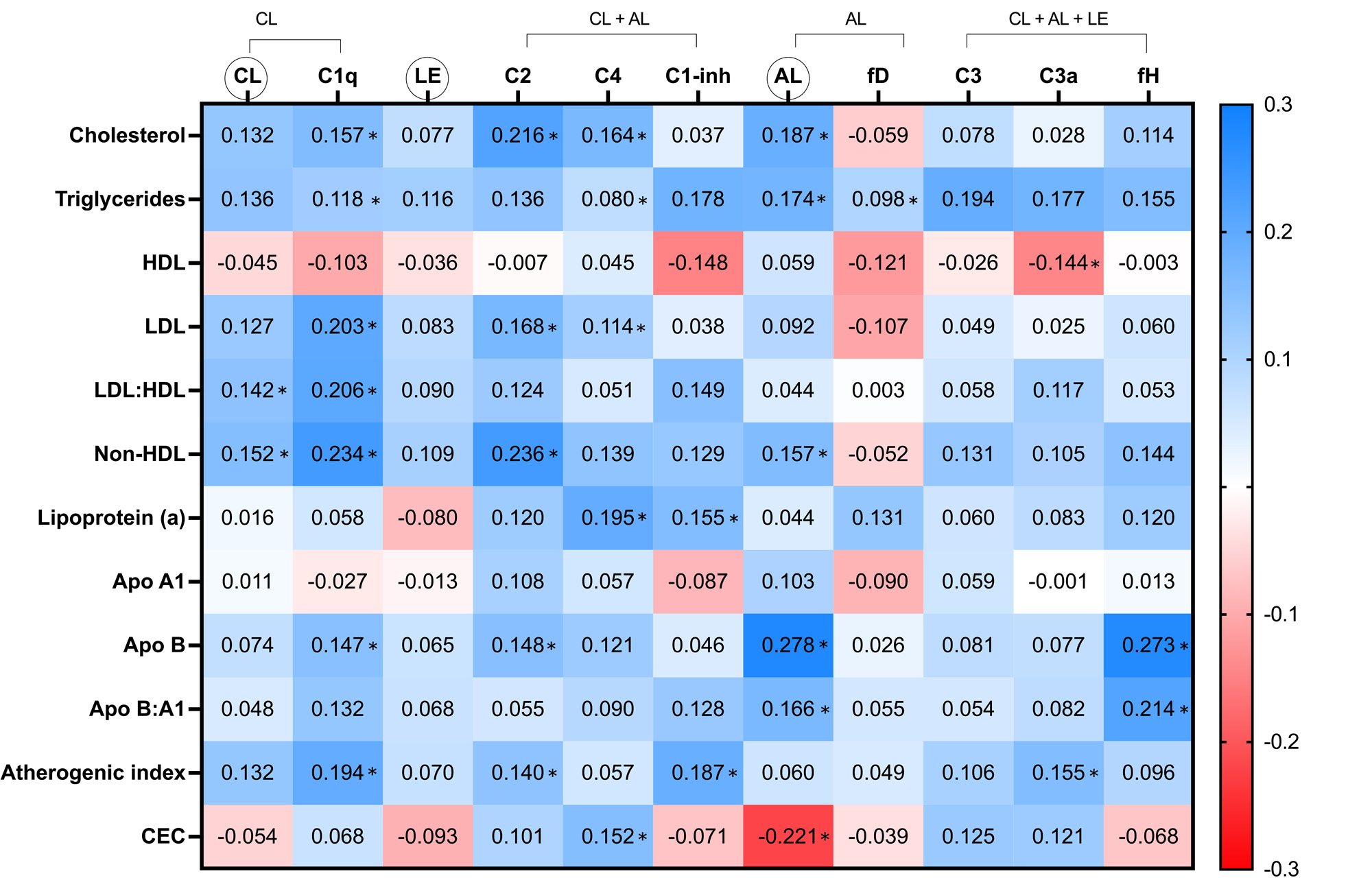Session Information
Date: Sunday, November 12, 2023
Title: (0543–0581) SLE – Diagnosis, Manifestations, & Outcomes Poster I
Session Type: Poster Session A
Session Time: 9:00AM-11:00AM
Background/Purpose: Cholesterol efflux capacity (CEC), the ability of high-density lipoprotein (HDL) cholesterol to accept cholesterol from macrophages, has been linked to cardiovascular events. Systemic lupus erythematosus (SLE) is characterized by the consumption of complement (C) proteins, and has been associated with an increased risk of cardiovascular disease. CEC is reduced in SLE patients compared to controls. In the present work, our objective was to analyze whether the disruption of C influences CEC in patients with SLE.
Methods: New generation functional assays of the three pathways of the C system were performed in 207 patients with SLE. Additionally, serum levels of inactive (C1q, C2, C3, C4, factor D) and activated (C3a) molecules, and regulators (C1-inhibitor and factor H) of C system were measured. CEC, using an in vitro assay, and lipoprotein serum concentrations were assessed. Multivariable linear regression analysis was performed to assess the relationship between C system and CEC.
Results: Overall, no associations were found between disease characteristics or comorbidity and CEC. Only the use of methotrexate showed a significant relationship to CEC (beta coef. 3 [95%CI 0.8-4], p=0.005). Besides, the presence of hypertension and Katz index showed a trend to be associated with CEC, although, in these cases, statistical significance was not reached.
The univariable association of these lipid pattern related molecules with the cascades and individual components of the C system is exposed as Spearman’s Rho correlation coefficients in Figure 1. In this sense, many associations were found in the univariable analysis. Most of them turned out to be positive (blue in the heatmap). The strongest, with a coefficient greater than 0.2, were found between C1q (classical pathway) and the serum levels of LDL, LDL:HDL ratio, and non-HDL cholesterol; between C2 (classical and alternative pathway) and total cholesterol and non-HDL cholesterol; and between the functional test of the alternative pathway and apolipoprotein B and CEC. The molecules most associated with the activation of the three pathways were apolipoprotein B and the Apo B:ApoA1 ratio. CEC was significantly and positively associated with C4, but negatively with the alternative pathway functional assay. However, the functional test of the lectin pathway showed no association with any of the lipid pattern molecules.
The association of C functional assays and individual C elements with CEC is represented in Table 1. We performed a multivariable analysis controlling for hypertension, Katz index, methotrexate, azathioprine (disease related data that had a p value inferior to 0.20 in relation to CEC), statins intake, and all lipids profile molecules that were not derived from a formula (to avoid collinearity). After this adjustment, the functional assay of the alternative route showed a significant and negative relationship with CEC (beta coef. -0.02 [95%CI -0.04- -0.002], p=0.030). This was also de case for C2 and C3, in which the associations were found to be positive and statistically significant (Table 1).
Conclusion: C system and CEC are interconnected in patients with SLE.
To cite this abstract in AMA style:
Ferraz Amaro I, García-González M, Gómez-Bernal F, Quevedo-Abeledo J, Fernández-Cladera Y, González-Rivero A, Gonzalez-Gay M. HDL-Cholesterol Efflux and the Complement System Are Linked in Systemic Lupus Erythematosus [abstract]. Arthritis Rheumatol. 2023; 75 (suppl 9). https://acrabstracts.org/abstract/hdl-cholesterol-efflux-and-the-complement-system-are-linked-in-systemic-lupus-erythematosus/. Accessed .« Back to ACR Convergence 2023
ACR Meeting Abstracts - https://acrabstracts.org/abstract/hdl-cholesterol-efflux-and-the-complement-system-are-linked-in-systemic-lupus-erythematosus/


